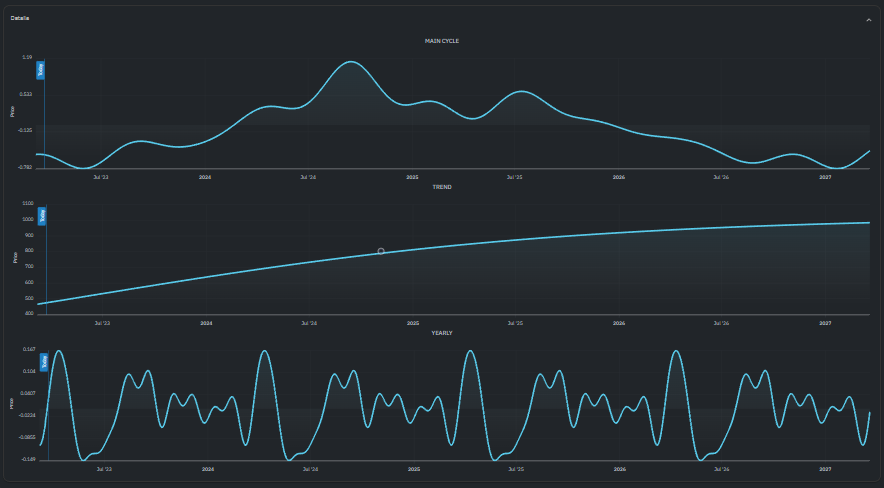20 Recommended Ways For Deciding On Chart Ai For Trading Websites
20 Recommended Ways For Deciding On Chart Ai For Trading Websites
Blog Article
Top 10 Tips For Assessing The Effectiveness And Reliability Of Ai Trading Platforms For Stocks
To ensure that you are using a system that can provide accurate predictions and information It is crucial to test the accuracy and efficacy of AI stock-predicting and analyzing platforms. Here are 10 tips to evaluate these platforms.
1. Backtesting Results
What to look for: Determine whether the platform allows backtesting to test how its predictions would've performed on previous data.
The reason it is important Backtesting can confirm the AI model's accuracy by comparing its predictions with actual outcomes from the past.
TIP: Pick platforms that let you customize the parameters of backtesting (e.g. time periods or asset types).
2. Real-time Performance Monitoring
What to look for What to look for: Examine how the platform performs under market conditions that are in real-time.
What's important: Real-time performance is an excellent indicator of the platform's effectiveness than just backtesting historical data.
Use a free trial or demo account to observe and compare the accuracy of real-time forecasts to the actual market movements.
3. Prediction Error Metrics
What to Look For Analyze metrics like Mean Absolute Error (MAE) or the Root Mean Squared Error (RMSE), or R-squared to quantify the accuracy of predictions.
What's the significance of these measures provide a quantifiable measure of the degree to which predictions correspond to the actual outcomes.
Platforms that share metrics openly tend to be more transparent.
4. Rate of Success and Win Rate
What to Watch Out For: Check for the platform's winning percentage (percentage that is based on accurate predictions) as well as its percentage of success.
Why it matters: A high win rate and success rate indicate higher forecasting accuracy and potential profits.
There is no perfect system. Beware of websites which promise unrealistic win rates, e.g. 90% %+),.
5. Benchmarking with Market Indices
What to look for Check the platform's predictions and results to major market indices, such as S&P 500 or NASDAQ.
Why It's Important It will allow you to determine whether your platform is outperforming or is underperforming the market overall.
Be sure to look for consistency in your performance, not only gains over a short period of time.
6. Consistency of Market Conditions
What to Look For What to look for: See what the platform's performance is under various market conditions.
Why It Matters A reliable platform should perform well across various market environments, not just in favorable conditions.
Test the platform's predictions during volatile markets or markets that are down.
7. Transparency in Methodology
What to Look For What to Look for: Learn AI algorithms and models (e.g. neural nets and reinforcement learning).
Transparency of methodology lets you evaluate the scientific rigor and reliability of the platform.
Avoid platforms with "black box" model that does not explain how the predictions were made.
8. User Reviews and Independent Testing
What to Look for: Read customer reviews and independent tests, or third-party assessments.
What's important Reviews and testing conducted by independent experts offer unbiased information about the accuracy of the platform and its performance.
Review user comments on forums such as Reddit copyright and financial blogs.
9. Risk-Adjusted Returns
What to look for What to look for: Evaluate the platform's performance by using risk-adjusted indicators such as the Sharpe Ratio or Sortino Ratio.
Why it is Important: This measurement measures the risk that is taken to realize the desired returns. It offers the most complete picture of the effectiveness.
Sharpe ratios (e.g. higher than 1) suggest a higher risk-adjusted rate.
10. Long-term Track Record
What to look for Check the performance of the platform over a long time (e.g. 3 to 5 years).
What is important: Long-term results are a better measure of reliability than short-term results.
Tips: Avoid platforms that demonstrate only temporary or limited success.
Bonus tip: Try the demo account
Demo accounts and free trials permit you to test the platform's predictions in real time, without putting any money on the line. It allows you to see the reliability of predictions as well as their performance.
These guidelines will help you determine the accuracy of AI stock-predicting and analysis platforms and choose one that matches your trading goals and tolerance for risk. Never forget that no platform is the perfect one. Combining AI insights with your research is the best way to go. View the most popular canadian ai stocks recommendations for website recommendations including ai trading bot, chart ai for trading, ai trading tools, best stock analysis app, best ai trading app, ai stock trading bot free, ai trading bot, best ai stock trading bot free, ai stock picks, using ai to trade stocks and more.
Top 10 Suggestions For Assessing The Risk Management Of Ai Stock-Predicting/Analyzing Platforms
Any AI stock-predicting/analyzing trading platforms must incorporate risk management that is crucial to protecting your capital and minimizing losses. Platforms with robust risk management tools will help you navigate the turbulent stock markets and make an informed decision. Here are 10 tips on how to assess the capabilities of the platform's risk management tools.
1. Examining Stop-Loss or Take Profit Features
Levels that can be customized - Make sure that the platform lets you adjust your stop-loss, take profit and profit levels for every strategy or trade.
Check the platform to see if it supports trailing stopped that will automatically adjust when the market moves towards you.
Stop-loss guarantees: Check to whether the platform offers stop-loss guarantee, which will guarantee that your account will be closed at a specified price even in volatile markets.
2. Calculate Position Size Tools
Fixed amount - Make sure that you are able to define the size of your positions relative to a specific amount.
Percentage: Check whether you can define your position sizes as percent of the total amount of your portfolio. This will enable you to control risk more effectively.
Risk-reward ratio: Check if the platform supports setting risk-reward ratios for individual strategies or trades.
3. Check for Diversification support
Multi-asset trading: Ensure the platform allows trading across multiple types of assets (e.g., ETFs, stocks and forex) to diversify your portfolio.
Sector allocation: Check whether the platform offers tools to monitor and manage sector exposure.
Diversification of geographical areas - Make sure that the platform supports trading on international markets. This can help diversify geographical risk.
4. Review margin and leverage controls
Margin requirements - Make sure that the platform clarifies margin requirements clearly.
Make sure your platform lets you to limit leverage to manage the risk of exposure.
Margin call - Check whether your platform informs you about margin calls in a timely manner. This will help prevent liquidation.
5. Assessment of Risk Analytics and Reporting
Risk metrics: Ensure that the platform provides the most important risk metrics to your portfolio (e.g. Value at Risk (VaR) Sharpe ratio and drawdown).
Scenario analysis: Check if the platform allows you to simulate different scenarios of market to determine the potential risk.
Performance reports: Make sure the platform provides you with detailed information on the performance of your investments, including returns that are risk-adjusted.
6. Check for Real-Time Risk Monitoring
Portfolio monitoring - Ensure that the platform you select has real-time monitoring in order to ensure your portfolio is safe.
Alerts: Check if you receive real-time alerts for events that are risk related (e.g. Stop-loss triggers, breach of margins).
Risk dashboards: Ensure that the platform has customized risk dashboards that give you a full picture of your personal profile.
7. Evaluate Stress Testing and Backtesting
Stress testing - Make sure your platform lets you test portfolios and strategies under extreme market conditions.
Backtesting: Check whether the platform allows backtesting of strategies using old data to gauge performance and risk.
Monte Carlo: Verify the platform's use Monte Carlo-based simulations for assessing risk and modeling a range of possible outcomes.
8. Risk Management Regulations: Assess compliance
Check for regulatory compliance: Make sure that the platform adheres to applicable risk-management regulations (e.g. MiFID II, Reg T, in the U.S.).
Best execution: Check to find out if your platform uses the best execution practices. This guarantees that trades will be executed at the most efficient price, minimising the chance of slippage.
Transparency: See if the platform provides clear and transparent disclosures about risks.
9. Examine for Risks that are User Controlled Parameters
Custom risk rules - Make sure that the platform allows you to create your own risk management guidelines.
Automated controls for risk: Check to see whether your system can enforce risk management rules based on the parameters you've set.
Make sure the platform supports manual overrides to automated risk controls.
Review Case Studies and User Feedback
User reviews: Conduct user research to assess the platform’s efficiency in risk management.
Testimonials and case studies They will showcase the platform’s risk management capabilities.
Community forums: Find out whether the platform has an active community of users who want to share strategies and strategies for managing risks.
Bonus Tips
Trial period: Take advantage of a demo free or trial to experience the risk management capabilities of the platform in realistic scenarios.
Support for customers: Ensure that your platform has a robust support to any questions or concerns related to managing risk.
Educational resources: Determine if you can find any educational materials that cover best practices in managing risk.
These tips will assist you in evaluating features of risk management provided by AI platform for predicting or analyzing stocks. You will be able select a platform that will safeguard your investment while limiting the possibility of losses. The use of robust risk management tools is vital to navigate the volatile markets and achieving long-term trading success. Read the most popular investment ai url for site examples including best stock analysis website, best ai stock trading bot free, ai trading bot, best ai etf, ai trading, investing ai, ai stocks, ai for trading, ai trading tools, ai chart analysis and more.